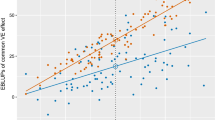Abstract
Evaluation of seedling populations assists in identifying those plants most desirable as parents for a breeding programme. A multivariate analysis of variance (Manova) showed that the seedling populations from 6 kiwifruit (Actinidia deliciosa) crosses differed in their overall merit. Discriminant functions were then used to identify the characters most powerful in distinguishing between populations. The populations were placed in order of their function scores which represent overall merit, and the superior populations were determined. The results showed that `Bruno' was a superior female parent for the production of seedlings with high discriminant function scores for floriferousness (male offspring)and productivity and high vitamin C content (female offspring). One male parent D-1-20 was consistently superior to D-1-6 the other male parent.
Similar content being viewed by others
References
Bryant, E.H. & W.R. Atchley, 1975. Multivariate Statistical Methods: Within-Groups Covariation. In: E.H. Bryant and W.R. Atchley (Eds.), New York, Dowden, Hutchins and Ross, Inc., Halsted Press.
Cole, J.W.L. & J.E. Grizzle, 1966. Applications of multivariate analysis of variance to repeated measurements experiments. Biometrics 22: 810–828.
Cooley, W.W. & P.R. Lohnes, 1971: Multivariate data analysis. New York, John Wiley & Sons, Inc.
Cruz-Castillo, J.G., S. Ganeshanandam, B.R. MacKay, G.S. Lawes, C.R.O. Lawoko & D.J. Woolley, 1994. Applications of canonical discriminant analysis in horticultural research. J Am Soc Hortic Sci 29: 1115–1119.
Cruz-Castillo, J.G., G.S. Lawes, D.J. Woolley & S. Ganesh, 1997. Evaluation of rootstock and 'Hayward' scion effects on field performance of kiwifruit vines using a multivariate analysis technique. N Z J Crop Hort Sci: 25: 273–282.
Evans, J.C. & E.A. Roberts, 1979. Analysis of sequential observations with applications to experiments on grazing animals and perennial plants. Biometrics 35: 687–693.
Manly, B.F.J., 1986. Multivariate Statistical Methods-a primer. London, Chapman and Hall Ltd.
SAS Institute Inc., 1985. SAS User's Guide: Statistics. Cary, NC, USA. SAS Institute Inc.
Smith, H., R. Gnanadesikan & J.B. Hughes, 1962. Multivariate analysis of variance (Manova). Biometrics 18: 22–41.
Wilks, S.S., 1932. Certain generalizations in the analysis of variance. Biometrika 24: 471–474.
Author information
Authors and Affiliations
Rights and permissions
About this article
Cite this article
Daoyu, Z., Lawes, G. Manova and discriminant analyses of phenotypic data as a guide for parent selection in kiwifruit (Actinidia deliciosa) breeding. Euphytica 114, 151–157 (2000). https://doi.org/10.1023/A:1003912911792
Issue Date:
DOI: https://doi.org/10.1023/A:1003912911792




